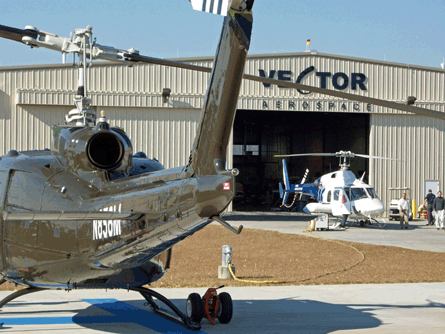Eurocopter's C$625 million ($653 milllion) acquisition of Toronto-based helicopter and engine maintenance provider Vector Aerospace is a major step for the manufacturer as it seeks to grow its aftermarket support business and foothold in America, particularly in respect to military and other government-operated aircraft. It should also help parent EADS move, at least a little bit, towards three key strategic goals.
Vector's 2010 turnover of C$545 million from operations in Canada, South Africa, the UK and the USA would boost Eurocopter's current support and services revenue of €1.7 billion ($2.4 billion) by more than a quarter. The deal is also expected to increase the aftermarket share of Eurocopter's revenue from 35% in 2010 to 40% in 2012.
2020 VISION
Vector thus plays to Eurocopter's long-term goal of more than doubling its MRO revenue to €4 billion over the next nine years, and it also helps EADS toward its objective of developing the non-Airbus parts of its portfolio, to get away from the prevailing situation that has the civil airliner division contributing a lion's share of total sales.
 |
|---|
© Vector AerospaceVector's 11 North American sites include two in Alabama |
Indeed, in 2009 and 2010 Airbus - which since 2009 has included its small military transport unit - accounted for 66% of group revenue. Given Airbus's run of record years, the group is clearly facing a struggle to achieve its goal of a 50/50 Airbus/non-Airbus revenue mix by 2020.
EADS boss Louis Gallois says: "This acquisition perfectly fits EADS's Vision 2020 strategy."
Royal Bank of Scotland equity analyst Sandy Morris agrees, and sees the deal as a "natural, perfectly logical bolt-on acquisition" for Eurocopter's core manufacturing business. But he adds that the immediate impact of the deal will be limited: "If they [EADS] make five of these acquisitions over the next nine years as part of Vision 2020, it would be significant."
However, Morris is not concerned about the 50/50 goal, which he sees as neither particularly important in the scheme of EADS's financial health nor likely to be achievable given the roaring success of the Airbus division.
What is more significant, both to Gallois and to analysts such as Morris, is EADS's bottom line. Gallois describes the group's profitability as unsatisfactory - EADS lost €322 million before interest and taxes (EBIT) in 2009 and made a mere €1.23 billion in 2010, less than 2.8% of revenue.
Eurocopter as a unit eclipsed that at 4.1%, while Vector's 2010 EBIT of C$45 million represented an 8.2% margin, proving the general rule that the aftermarket, not original equipment, is where profits are made. Also significant is the lifetime revenue stream that comes with parts and service.
Eurocopter declined to comment on its development plans for Vector, but it will be run as a separate unit, retain its own management team, and keep the existing brand name.
It will also continue to support - and potentially expand services - for aircraft made by manufacturers other than its new European parent. Vector co-operates, for example, with Sikorsky.
In the long-term, however, Eurocopter plans to provide this kind of support without outside assistance, says a source familiar with the deal.
While EADS says the acquisition ensures a "good balance" between military and civil activities, Eurocopter chief executive Lutz Bertling says that the takeover provided the manufacturer with "a high-level of expertise, especially in public-private partnerships for the maintenance on governmental aircraft".
A third key benefit of the deal comes from currency. EADS, like other European manufacturers, has been hammered in recent years by the aerospace industry's general practice of pricing aircraft in US dollars, which have been relatively weak compared with the euros with which it must meet its costs at home. Growth in North America provides a so-called natural hedge against this currency headwind.
Expanding its North American aftermarket business is also a natural route to growth for Eurocopter, which commands half the market for helicopter sales to US law enforcement authorities. The US Army operates the EC145-based UH-72A Lakota light utility helicopters and plans to grow this fleet to 345 aircraft.
In total, about 600 US customers operate 1,800 Eurocopters.
Source: Flight International
















